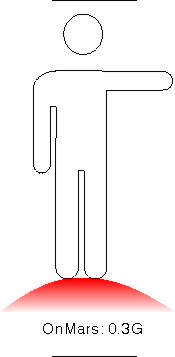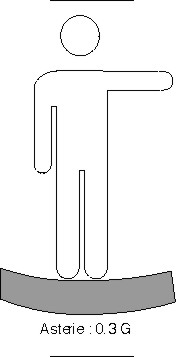
Many ships and stations in 2300ad use rotation to simulate the effects of gravity to avoid the damaging effects (bone mass loss, space sickness, impared immune system etc.) of zero gravity on the human body.
By spinning the habitat around some central point (a variety of geometries can be used to achieve this effect) a person standing within the habitat experiences an acceleration similar to gravity. The amount of acceleration experienced depends upon the radius of the rotation and the number of revolutions per second. For very large radii and very low rotation rates the "gravity" in a spin habitat is indistinguishable to a human to that of a planet. Very large spin habitats are however also very expensive habitats and are few and far between (L5 is the most well known example). On most ships and most colonial space stations construction and transportation costs mean that radii tend to be small and rotation rates relatively high.
Unfortunately as the radius decreases and the rotation rate increases even an untrained human begins to notice that "spin gravity" differs substantially from planetary gravity.
The purpose of spin habitats is to provide sufficient "spin gravity" to keep the human body, which evolved over millions of years to function in Earth's 1.0G gravity field, functioning properly. 300 years of space flight and life off planet Earth have demonstrated that 0.3G is the minimum gravity that a human can tolerate without significant degradation (both temporary and permanent). Even at 0.3G drugs and dietary supplements are required to maintain the body in anything close to normal levels of fitness.
Given a 0.3G minimum there is another issue facing the spin habitat designer. This is that rotation rates above 3 revolutions per minute (rpm) will cause motion sickness in most individuals. Thus any spin habitat has to ensure both a minimum 0.3G "spin gravity" and a maximum rotation rate of 3 rpm. The minimum radius that meets both these requirements is 35m.
The Colonist Modules for the French Asterie Class Colony Vessels, built to transport thousands of colonists up the French Arm, used these parameters in their spin habitat design. All the following examples use the parameters of the Asterie module for the spin habitat.
On a planet or moon the mass of the celestial body attracts the mass of the person resulting in a vertical force (gravity) pulling the person towards the center of the body. The force of the person pressing down against the ground results in an equal and opposite force (Newton's Third Law of Motion) of the ground pressing up against the soles of the person's feet.
In a spin habitat the floor of the habitat pushes vertically up against the soles of the person's feet in order to keep the person rotating around the centre of the habitat along with the floor (this is known as the centripetal force). The centripetal force results in an equal and opposite force (the centrifugal force) from the person's feet pushing down against the flooring. Thus from the point of view of the person the spin habitat produces very similar forces to standing on a planet and therefore a very similar feeling.
The working of the spin habitat can be illustrated by considering what happens when a person standing in such a habitat drops a ball. Once the ball is released it is no longer connected to the habitat consequently it continues to travel in a straigth line, horizontally across the diagram below (Newton's First Law of Motion). The person however is subject to the centripetal force which acts in a straight line between the person's feet and the center of rotation to keep them rotating around the center of the habitat. At the moment the ball is released the centripetal force acts vetically upwards in the diagram however as the rotation contiues the force begins to push the person to the left as well as upwards. Thus relative to the ball the person is being pushed both upwards and to the left. Eventually the ball's line of flight will bring it into contact with the habitat floor by which time the person will have been forced upwards and slightly to the left so that the ball lands to the right of the point immediately below the person's outstretched hand.

From the point of view of the spin habitat's residents the centripetal force gives the feeling of (in this example) a 0.3G gravity. The behaviour of the dropped ball will however be a little different to that of a ball dropped on a planet. The diagram below shows, from the point of view of the person, what happens when the same ball is dropped from a height of 1.5m on the Earth, Mars and an Asterie Colonist Module (a 35m radius, 2.77 rpm spin habitat). The animation is in real time with each frame 0.05 seconds apart.
 |
 |
 |
 |
On Earth or Mars the ball drops vertically to land immediately below the hand that dropped it. On the Asterie however the ball falls down and to the right, actually in the direction in which the module is rotating, so that it falls (from the point of view of the resident) in a curve.